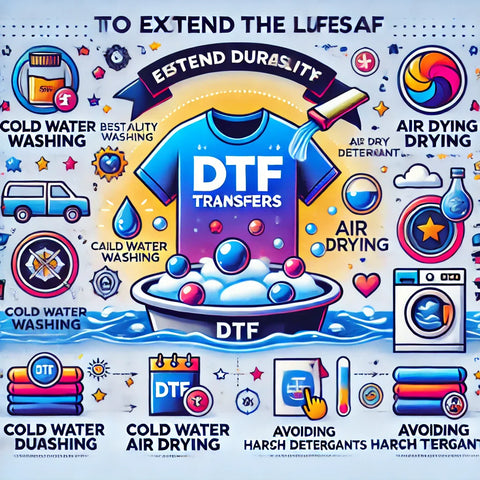DTF (Direct-to-Film) printing is known for producing high-quality, vibrant, and flexible prints. However, without proper care, even the best DTF transfers can fade, crack, or peel over time. Whether you’re running a DTF business or using the technology for personalized clothing, knowing how to preserve your prints is essential.
In this guide, you’ll learn expert tips to extend the lifespan of your DTF transfers and keep them looking fresh and durable for years.
1. Why Proper DTF Transfer Care Matters?
✔ Why It’s Important:
Poor washing, drying, or handling can cause DTF transfers to degrade quickly. Ensuring proper care extends their vibrancy, adhesion, and flexibility.
✔ Common Issues Without Proper Care:
❌ Fading Colors – Overwashing or using harsh detergents.
❌ Cracking & Peeling – High heat or improper storage.
❌ Weak Adhesion – Low-quality transfer film or incorrect application.
📌 Pro Tip: Well-maintained DTF prints last up to 50+ washes while staying soft and stretchable.
🚀 Example: A DTF-printed hoodie that’s washed in hot water and tumble-dried on high heat will start cracking within a few washes.
2. Choosing High-Quality DTF Materials for Durability
✔ Why It Matters:
The quality of your materials directly impacts how long your DTF transfers last.
✔ Key Factors for Durable DTF Prints:
✅ Use Premium DTF Film – High-release films ensure better ink adhesion.
✅ Choose High-Quality Inks – Low-quality inks fade quickly after washes.
✅ Opt for Correct Powder Adhesives – Ensures strong bonding to the fabric.
✅ Select Compatible Fabrics – Cotton, polyester blends, and soft synthetic fabrics work best.
📌 Pro Tip: Avoid using cheap DTF materials—investing in quality films, inks, and powders leads to longer-lasting prints.
🚀 Example: A high-quality DTF print on a premium cotton T-shirt will outlast a low-quality print on a synthetic fabric.
3. Proper Washing Instructions for DTF Transfers
✔ Why It Matters:
Incorrect washing fades colors, weakens adhesion, and shortens the print’s lifespan.
✔ Best Washing Practices for DTF Prints:
✅ Wash Inside-Out – Protects the printed surface from friction.
✅ Use Cold Water – Hot water damages print pigments.
✅ Select Gentle Detergents – Harsh chemicals fade and weaken the print.
✅ Avoid Bleach & Fabric Softeners – These break down DTF inks and adhesive layers.
📌 Pro Tip: Hand washing in cold water significantly increases the lifespan of DTF prints.
🚀 Example: A DTF-printed sports jersey washed in harsh detergent loses vibrancy after just a few washes.
4. Drying Your DTF Prints the Right Way
✔ Why It Matters:
High heat damages the DTF film, adhesive, and ink pigments, leading to peeling and cracking.
✔ How to Dry DTF Prints Correctly:
✅ Air Dry When Possible – Best for preserving print elasticity.
✅ Avoid High-Heat Dryers – Excessive heat melts the adhesive layer.
✅ Tumble Dry on Low (if necessary) – Use the lowest setting to prevent damage.
✅ Avoid Direct Sunlight – UV rays fade print colors over time.
📌 Pro Tip: If using a dryer, place the garment inside-out in a laundry bag to reduce friction and heat exposure.
🚀 Example: A DTF-printed hoodie air-dried maintains its softness and stretchability longer than one dried on high heat.
5. Ironing & Heat Exposure: How to Prevent Damage?
✔ Why It Matters:
Excessive heat melts DTF adhesives and causes prints to crack or peel.
✔ Ironing & Heat Protection Tips:
✅ Turn Inside-Out Before Ironing – Avoid direct heat contact.
✅ Use a Pressing Cloth – Place a cotton cloth over the print while ironing.
✅ Set to Low Heat – High temperatures can warp the film.
✅ Avoid Steam & Moisture – Water weakens DTF adhesive bonds.
📌 Pro Tip: Use a heat press at low pressure instead of a direct iron to remove wrinkles safely.
🚀 Example: A DTF-printed polyester T-shirt ironed on high heat melts and distorts the print.
6. Storing DTF-Printed Garments for Longevity
✔ Why It Matters:
Poor storage conditions cause premature wear, cracking, and ink degradation.
✔ Best Storage Practices:
✅ Hang Instead of Folding – Avoids creases that crack prints.
✅ Store in a Cool, Dry Place – Humidity weakens the adhesive layer.
✅ Use Silica Gel Packets – Prevents moisture buildup inside storage areas.
✅ Avoid Plastic Bags – Traps moisture, leading to sticky or damaged prints.
📌 Pro Tip: For bulk storage, wrap garments in acid-free tissue paper to prevent friction damage.
🚀 Example: A DTF-printed shirt stored in a humid area will develop cracks and peeling much faster.
7. How to Fix Minor Peeling or Cracking on DTF Prints?
✔ Why It Matters:
Sometimes, even well-maintained DTF prints experience minor peeling.
✔ Quick Fix for Peeling DTF Prints:
✅ Use a Heat Press at 300°F (150°C) for 10-15 seconds to reactivate the adhesive.
✅ Apply Pressure with a Teflon Sheet to reseal peeling edges.
✅ Avoid Overheating – Excess heat can cause further damage.
📌 Pro Tip: If peeling occurs often, review your initial transfer process & washing techniques.
🚀 Example: A DTF print that starts peeling after excessive drying heat can be repaired with a heat press reapplication.
Final Thoughts: How to Ensure Long-Lasting DTF Transfers
📌 Key Takeaways:
✔ Use high-quality DTF film, ink, and adhesive powders for best durability.
✔ Wash inside-out with cold water & mild detergent to prevent fading.
✔ Avoid high heat drying & direct sunlight exposure.
✔ Iron inside-out on low heat with a protective cloth.
✔ Store garments properly to prevent moisture damage.
✔ Reheat peeling edges with a heat press to fix minor issues.
🚀 Want your DTF prints to last longer? Follow these best practices, and enjoy vibrant, crack-free designs wash after wash!






